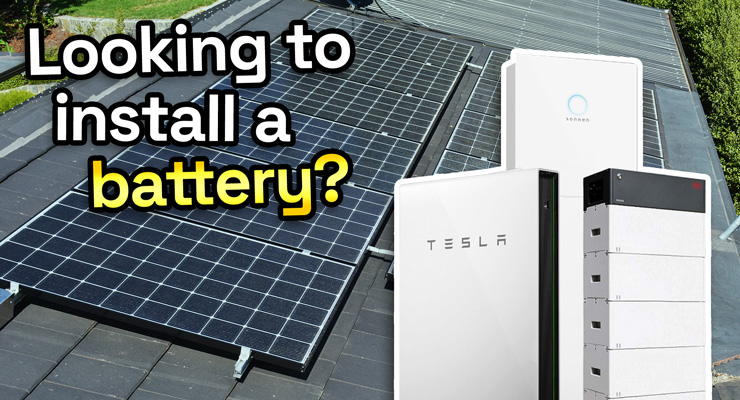Fast read
Enhance your solar power system with a battery for optimal efficiency. Start by assessing your system's ability to charge a battery, ensuring you generate a surplus of solar power each day. A typical 3kw system produces around 13kwh daily, so consider a 2-4kwh battery for peak use or blackouts.
Upgrade options involve increasing your solar capacity, allowing for a 6-10kwh+ battery. Define your goals, like saving daytime solar power for evening use (typically 8-10kwh for households) and ensuring essential functions during blackouts.
Limit essential devices during blackouts to avoid excess costs. Explore new uses for your battery, such as selling power during peak grid events.
A 3kw system is relatively small; consult an expert to design a tailored solution, considering energy usage patterns, future changes, and panel additions. A larger system paired with a battery is likely the most beneficial choice.
What to consider before installing a battery on your 3kw Solar System
Not all 3kw solar systems have the potential to incorporate batteries. While many solar systems are marketed as “battery ready” or “battery upgradeable,” homeowners should find it feasible to add a battery to any existing grid-tied solar system.
Here, the battery, which requires a “solar battery inverter,” sits between the solar panel inverter and the home’s main switchboard.
Typically, sensors like Current transformers connect to the meter board to detect when the electricity generated from the solar system exceeds the electricity consumed in the home. Essentially, these sensors measure the surplus power sent back to the grid. Once the monitoring system detects excess power generation, it utilises this electricity to charge the battery and store it until needed for household use later on.
There are several options on the market now for AC-coupled batteries, with the most well-known being the Tesla Powerwall. However, there are several well-recognised other options, including, Sungrow, Sonnen, Qcells, and Victron, among others, to choose from.
While basically all grid-connected solar systems in Australia have the potential to have batteries added, the key criterion is having the electricity generation capacity to charge the battery. To maximise the potential, there are several important factors to consider in this process.
Charging the battery
Firstly, you need to evaluate whether your existing solar system can effectively charge a battery. To understand this, determine how much solar power you use at home and how much you send back to the grid.
First, calculate the amount of solar power you consume in your household. Next, calculate the amount of solar power you send back to the grid. To accommodate a battery, you must generate a surplus of solar power each day that is currently being exported.
A typical perfectly north-facing 3kw solar system, on average, produces around 13kwh of electricity daily, with variations in different seasons. After accounting for energy consumption within your home, you may have only a few kilowatt-hours of excess electricity available for charging a battery.
Consequently, a smaller battery with a capacity of 2-4kwh might be the most practical choice. Consider what essential appliances or devices you’d like to power during peak periods or in case of a blackout, taking into account the frequency and duration of blackouts in your area
Clearly, there is no point in adding a battery unless you have the electricity available from your solar panel system to charge the battery with.
First, examine your online monitoring (if available) to observe the daily electricity export to the grid. Ideally, you should observe that you are exporting more electricity to the grid than the capacity of the battery. This ensures that, under normal circumstances, the battery will be fully charged and available daily.
Upgrading your 3kw Solar System
The second option involves upgrading your existing 3kw solar system or adding additional solar capacity. This would enable you to install a larger battery, ranging from 6kwh to 10kwh or even more. For many, this is the recommended solution.
When contemplating this upgrade, it’s essential to define your goals for installing the battery and how you intend to utilise the stored electricity. Several potential uses and considerations should influence your choice of battery size and solar system capacity. One primary reason for adding a battery is to save excess solar power generated during the day for use during the evening peak and overnight. Therefore, it is crucial to assess your evening and overnight electricity consumption, which typically ranges from 8-10kwh for an average household.

Essential electrics
Additionally, you should factor in the potential for blackouts and which essential electrical devices you’d like to keep operational during such times (e.g., refrigerator, lights, fan, modem, laptop). It’s wise to limit these devices to essentials to avoid excessive costs associated with increasing your battery capacity for this purpose. Furthermore, exploring emerging applications for your battery, such as participation in Virtual Powerplants, where you can earn income by selling excess power during peak grid events, is worth considering.
By current standards, a 3kw solar system is relatively small, especially when compared to the average system size in Australia, which is around 8kw and larger. We recommend consulting with an experienced solar designer and salesperson to assess your home’s energy usage patterns. They can create a solar and battery solution that aligns with your family’s needs.
This evaluation should consider your current electricity consumption, the potential for future changes (e.g., electric vehicle charging, expanding your family), and the feasibility of adding more solar panels to your roof. For most households, this analysis will likely suggest that opting for a solar system larger than 3kw combined with a battery, is a more beneficial and sustainable choice.
Sizing the battery for your 3kw Solar System
Also worth considering is what size battery you would need and why. While storing the electricity in a battery is great, it is only as good as your ability to use it.
Or if there are other peak periods in the middle of the day where solar may not provide all the power for the household’s needs at that time that a battery could used for. It is advised to consider the average evening electricity usage to get the most value from the battery.
If you go too large and can’t use the full capacity regularly, the value and return diminish. The exception would be if you are looking for a battery to guarantee some level of backup capacity. In the event of a blackout, installing a larger battery provides reserved capacity that’s only accessible if the grid connection is lost.
Before adding a battery to your existing solar system, consider the key factors. Such as ensuring your system generates an electricity surplus for effective battery charging, and assessing your daily energy exports to guarantee ample capacity. You might need to upgrade your solar system.
Sizing the battery should align with your evening consumption. Oversizing is unnecessary unless you seek backup power during blackouts. Consulting a solar expert can help tailor the solution to your needs, often favouring a larger solar system paired with a battery for maximum benefits.
